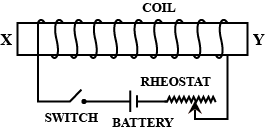
The diagram shows a coil wound around a soft iron bar XY. State the polarity at the ends X and Y as the switch is pressed:

(A) X- north pole, Y-south pole
(B) X- north pole, Y-north pole
(C) X- south pole, Y-south pole
(D) X- south pole, Y-north pole
Answer
220.2k+ views
Hint: Magnetic fields curl around a wire carrying electric current. Right hand thumb rule can be used accordingly. According to the right thumb rule the magnetic lines move away from us which is similar in case of a magnet do the side from which the magnetic field lines are out it is considered as North Pole and the opposite side as South Pole.
Complete Step-by-Step solution When the current flows in a wire, magnetic loops are formed around it. The direction of the magnetic field lines can be measured with the help of your right hand. If your thumb is in the direction of the electric current in a straight wire, then your fingers will curl in the direction of magnetic field lines. In this case, when we see the solenoid from the top view, where X is above Y, the current will look like moving in an anti-clockwise direction. Therefore, applying the right-hand thumb rule, the magnetic field lines appear to be moving towards us (i.e. from Y to X). Similarly, when we see the solenoid from the bottom view, where Y is above X, the current will look like moving in a clockwise direction, therefore applying the thumb rule, the magnetic field lines appear to be moving away from us. This is similar to a magnet, so the side giving out magnetic field lines is said to be North Pole and the side taking in magnetic field lines is said to be South Pole. This will also form a closed loop. Thus, the polarity of the solenoid XY at X is North Pole and at Y is South Pole.
Hence the correct answer is A
Note Magnetic monopoles do not exist and magnetic field lines will always form a closed loop. Every magnet has dipole nature; it consists of both north and South poles. Even when the magnet is broken or cut into many pieces every part cut behaves as an individual magnet consisting of north and south poles.
Complete Step-by-Step solution When the current flows in a wire, magnetic loops are formed around it. The direction of the magnetic field lines can be measured with the help of your right hand. If your thumb is in the direction of the electric current in a straight wire, then your fingers will curl in the direction of magnetic field lines. In this case, when we see the solenoid from the top view, where X is above Y, the current will look like moving in an anti-clockwise direction. Therefore, applying the right-hand thumb rule, the magnetic field lines appear to be moving towards us (i.e. from Y to X). Similarly, when we see the solenoid from the bottom view, where Y is above X, the current will look like moving in a clockwise direction, therefore applying the thumb rule, the magnetic field lines appear to be moving away from us. This is similar to a magnet, so the side giving out magnetic field lines is said to be North Pole and the side taking in magnetic field lines is said to be South Pole. This will also form a closed loop. Thus, the polarity of the solenoid XY at X is North Pole and at Y is South Pole.
Hence the correct answer is A
Note Magnetic monopoles do not exist and magnetic field lines will always form a closed loop. Every magnet has dipole nature; it consists of both north and South poles. Even when the magnet is broken or cut into many pieces every part cut behaves as an individual magnet consisting of north and south poles.
Recently Updated Pages
Electricity and Magnetism Explained: Key Concepts & Applications

JEE Energetics Important Concepts and Tips for Exam Preparation

JEE Isolation, Preparation and Properties of Non-metals Important Concepts and Tips for Exam Preparation

JEE Main 2021 July 25 Shift 1 Question Paper with Answer Key

JEE Main 2021 July 22 Shift 2 Question Paper with Answer Key

States of Matter Chapter For JEE Main Chemistry

Trending doubts
JEE Main 2026: Application Form Open, Exam Dates, Syllabus, Eligibility & Question Papers

Understanding Uniform Acceleration in Physics

Derivation of Equation of Trajectory Explained for Students

Hybridisation in Chemistry – Concept, Types & Applications

Understanding the Angle of Deviation in a Prism

Understanding Atomic Structure for Beginners

Other Pages
JEE Advanced Marks vs Ranks 2025: Understanding Category-wise Qualifying Marks and Previous Year Cut-offs

Dual Nature of Radiation and Matter Class 12 Physics Chapter 11 CBSE Notes - 2025-26

How to Convert a Galvanometer into an Ammeter or Voltmeter

Understanding Centrifugal Force in Physics

JEE Main Marking Scheme 2026- Paper-Wise Marks Distribution and Negative Marking Details

Degree of Dissociation: Meaning, Formula, Calculation & Uses




